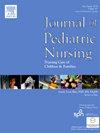The effect of toy-figure nebulizer along with amigurumi-based therapeutic play, and auditory stimulus reduction during inhalation therapy in children: A randomized controlled trial
IF 2.3
4区 医学
Q2 NURSING
Journal of Pediatric Nursing-Nursing Care of Children & Families
Pub Date : 2025-09-27
DOI:10.1016/j.pedn.2025.09.021
引用次数: 0
Abstract
Purpose
This study evaluated the effects of therapeutic play using an amigurumi toy and a toy-figure nebulizer, along with inhalation therapy involving reduced auditory stimuli, on fear levels, emotional responses, and physiological parameters in children undergoing treatment in a pediatric emergency department.
Methods
A randomized controlled trial was conducted with 90 children aged 3–6 years who received inhalation therapy at the Pediatric Emergency Department of a state hospital between June –December 2023. Data were collected using a Descriptive Information Form, the Children's Fear Scale (CFS), the Children's Emotional Manifestation Scale (CEMS) and Physiological parameter monitoring form.
Results
Children in both the therapeutic play and reduced auditory stimulus groups demonstrated significantly lower mean scores on the CFS and CEMS, as well as lower respiratory rates during inhalation therapy, than their pre-intervention values and those of the control group (p = 0,012, p < 0.001, p < 0.001).
Conclusion
Therapeutic play and auditory stimulus reduction during inhalation therapy in the pediatric emergency department were found to significantly reduce children's fear levels and negative emotional indicators. Additionally, children in the intervention groups exhibited lower respiratory rates than those receiving routine care.
Practice implications
Incorporating therapeutic play with an amigurumi toy and using a toy-figure nebulizer, with auditory stimulus reduction, represents a practical and effective approach to minimizing fear and negative emotional responses in children undergoing inhalation therapy in pediatric emergency settings.
儿童吸入治疗期间,玩具喷雾器与阿米格鲁治疗性游戏和听觉刺激减少的效果:一项随机对照试验。
目的:本研究评估了在儿科急诊科接受治疗的儿童中,使用amigurumi玩具和玩具人物喷雾器进行治疗性游戏,以及涉及减少听觉刺激的吸入疗法对恐惧水平、情绪反应和生理参数的影响。方法:对2023年6月至12月在某州立医院儿科急诊科接受吸入治疗的90名3-6岁儿童进行随机对照试验。采用描述性信息表、儿童恐惧量表(CFS)、儿童情绪表现量表(CEMS)和生理参数监测表收集数据。结果:治疗性游戏组和减少听觉刺激组患儿的CFS和CEMS平均得分均显著低于干预前和对照组,吸入治疗期间呼吸频率显著低于对照组(p = 0.012, p)。在儿科急诊科进行吸入治疗时,治疗性玩耍和减少听觉刺激可显著降低儿童的恐惧水平和负面情绪指标。此外,干预组的儿童比接受常规护理的儿童呼吸频率低。实践意义:在减少听觉刺激的情况下,结合使用amigurumi玩具和玩具形象雾化器进行治疗性游戏,是一种实用而有效的方法,可以最大限度地减少在儿科急诊环境中接受吸入治疗的儿童的恐惧和负面情绪反应。
本文章由计算机程序翻译,如有差异,请以英文原文为准。
求助全文
约1分钟内获得全文
求助全文
来源期刊

Journal of Pediatric Nursing-Nursing Care of Children & Families
NURSING-PEDIATRICS
CiteScore
3.70
自引率
8.30%
发文量
291
审稿时长
65 days
期刊介绍:
Official Journal of the Society of Pediatric Nurses and the Pediatric Endocrinology Nursing Society (PENS)
The Journal of Pediatric Nursing: Nursing Care of Children and Families (JPN) is interested in publishing evidence-based practice, quality improvement, theory, and research papers on a variety of topics from US and international authors. JPN is the official journal of the Society of Pediatric Nurses and the Pediatric Endocrinology Nursing Society. Cecily L. Betz, PhD, RN, FAAN is the Founder and Editor in Chief.
Journal content covers the life span from birth to adolescence. Submissions should be pertinent to the nursing care needs of healthy and ill infants, children, and adolescents, addressing their biopsychosocial needs. JPN also features the following regular columns for which authors may submit brief papers: Hot Topics and Technology.
 求助内容:
求助内容: 应助结果提醒方式:
应助结果提醒方式:


